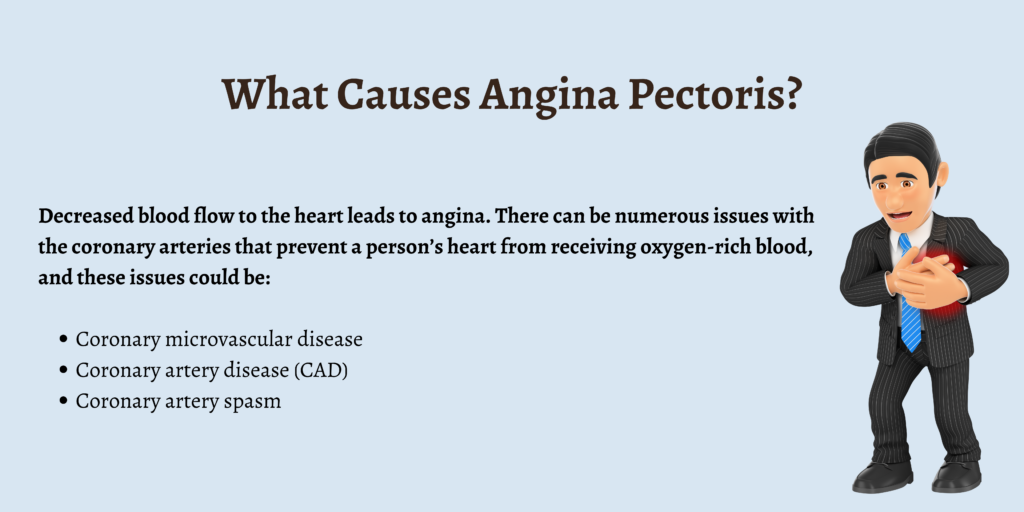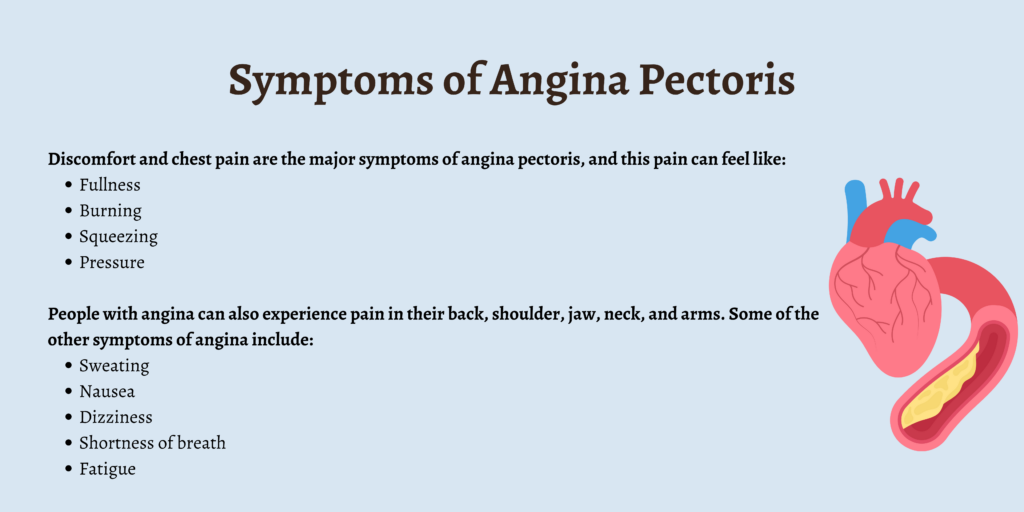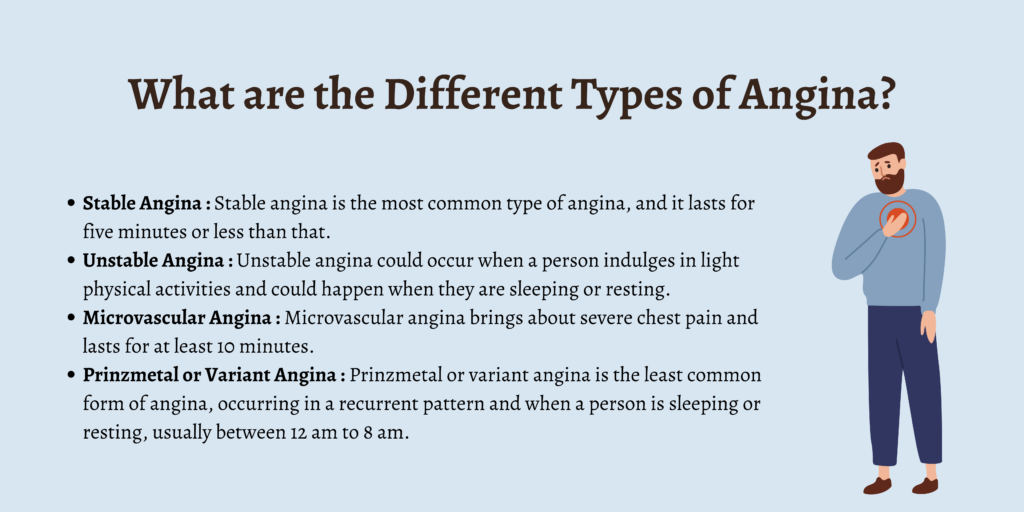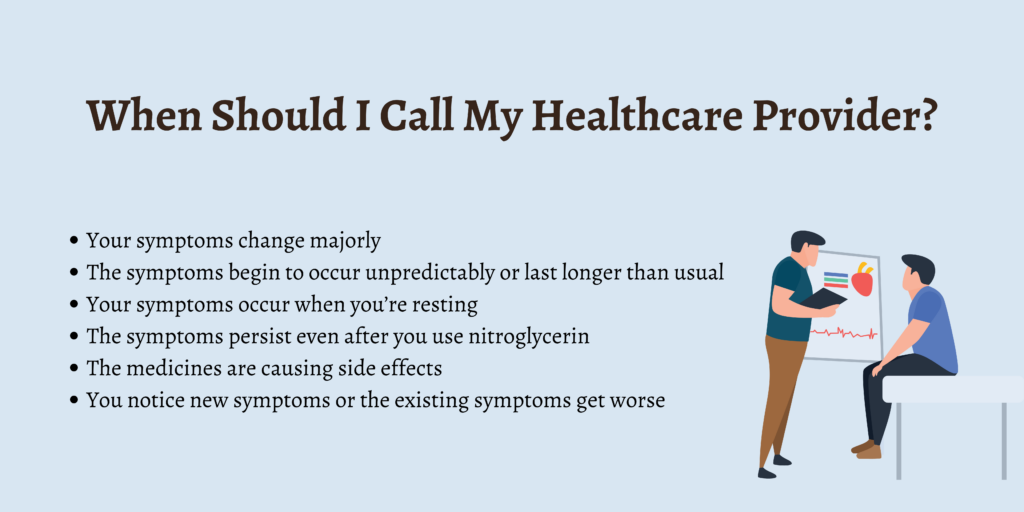What is Angina Pectoris?
Angina or angina pectoris is chest pain or discomfort that occurs due to reduced blood flow to the heart. Since the heart doesn’t receive enough blood rich in oxygen, in such a situation, it leads to the heart beating harder and faster to get more blood, which causes pain.
Angina shouldn’t be confused as a disease. Instead, it’s a warning sign and symptom of heart disease. Although angina is not uncommon, it can still be tricky to differentiate it from other kinds of chest pain, such as the type that occurs during indigestion.
Therefore, if you suddenly experience chest pain that can’t be explained, you should contact your doctor right away.
What Does Angina Pectoris Feel Like?
People with angina describe it as a feeling of pressure or chest pain. While some say it feels like indigestion, others compare it to tightness or squeezing sensation in the chest.
The discomfort associated with angina pectoris usually initiates behind the breastbone, and people can often find it difficult to pinpoint the location of the pain. The discomfort or pain in the chest could spread to other regions in the upper body as well, including the belly, arms, jaw, neck, or shoulders.
What Causes Angina Pectoris?
Decreased blood flow to the heart leads to angina. There can be numerous issues with the coronary arteries that prevent a person’s heart from receiving oxygen-rich blood, and these issues could be:
- Coronary microvascular disease
- Coronary artery disease (CAD)
- Coronary artery spasm
Symptoms of Angina Pectoris
Discomfort and chest pain are the major symptoms of angina pectoris, and this pain can feel like:
- Fullness
- Burning
- Squeezing
- Pressure
People with angina can also experience pain in their back, shoulder, jaw, neck, and arms. Some of the other symptoms of angina include:
- Sweating
- Nausea
- Dizziness
- Shortness of breath
- Fatigue
What are the Different Types of Angina?
There are four different types of angina, and they are:
Stable Angina
Stable angina is the most common type of angina, and it lasts for five minutes or less than that. It’s a symptom of coronary artery disease, and medicines or rest usually help in treating it.
This type of angina is predictable and mostly similar to previous events of chest pain.
The symptoms of it are:
- Pain, fullness, or pressure in the middle of the chest
- The person could experience signs similar to indigestion or gas
- The feeling can possibly spread to the person’s arm, shoulder, back, neck, or jaw
One could experience it:
- While going through strong emotions.
- During periods of physical exertion.
- Post a huge meal.
- When the weather is too hot or too cold.
- Whenever the heart has to work extra hard for some reason.
Unstable Angina
Unstable angina could occur when a person indulges in light physical activities and could happen when they are sleeping or resting. It’s unpredictable and could get worse with time. It can be an indication of a heart attack and doesn’t go away through rest or medicine.
Here are some of the things to know about unstable angina:
- The pain experienced during unstable angina is quite different from the type felt during stable angina
- The pain can last for over 20 minutes and can return after going away
- The pain is more severe in comparison to stable angina and could get worse
Microvascular Angina
Microvascular angina brings about severe chest pain and lasts for at least 10 minutes. It can occur during:
- Physical exertion
- While performing a daily activity
- During moments of strong emotions
It’s a sign of coronary microvascular disease, and medication may not help in curing it right away. Some of the symptoms of it include:
- Sleep issues
- Fatigue
- Sweating
- Shortness of breath
Prinzmetal or Variant Angina
Prinzmetal or variant angina is the least common form of angina, occurring in a recurrent pattern and when a person is sleeping or resting, usually between 12 am to 8 am.
Young people are usually affected by variant angina, and it’s a sign of coronary spasm. Medicines help in relieving the pain associated with this kind of angina, and the pain can also spread to the left shoulder, jaw, or neck.
The symptoms could include:
- Heavy chest pain
- Pressure or vague pain in the lower chest
- Sweat
- Nausea
- Fainting or dizziness
Clinical Features of Angina
- Pain behind the breastbone and spreading across the chest
- Pain referred to the throat, jaw and teeth also to the armpits and down into the arm
- Frequently described as a heaviness in the arms or chest
- Pale and sweaty skin
- Breathessness
- Usually relieved by rest and GTN
- The most significant clinical feature is the relationship to exertion, stress etc.
Angina Pectoris in Women
Women can often experience symptoms of angina that are different from the classic signs, which could lead to their treatment getting delayed. These symptoms can include:
- Nausea
- Pain in the stomach or abdomen
- Stabbing pain in place of pressure in the chest
- Discomfort in the back, teeth, jaw, or neck
- Shortness of breath
Complications and Risk Factors for Angina Pectoris
The risk factors for angina are quite a few, and some of them are as follows:
- Diabetes
- Heart failure
- Inflammation
- Chronic stress
- Obesity
- Anemia
- Not getting enough exercise or not moving around enough
- Misuse of drugs
- High blood pressure
- Consuming too much alcohol
- High cholesterol
- Certain medications
- Old age
- Metabolic syndrome
- Vaping, smoking, or using other types of tobacco products
- Being exposed to secondhand smoke for long periods of time
- Family history of heart disease
- Other health issues
- Diet that is too high in sodium, sugar, refined carbohydrates, trans fat, or fat
Anyone experiencing angina could find it difficult to engage in activities such as walking as the movement can feel uncomfortable. The biggest and most dangerous complication linked to angina is a heart attack.
How is Angina Pectoris Diagnosed?
When someone with angina visits a doctor, they will be asked about their medical history, after which a medical examination will be conducted. The doctor could ask to get certain tests done, such as:
- Electrocardiogram (ECG)
- Cardiac catheterization
- Coronary CT scan
- Cardiac MRI
- Stress test
How is Angina Pectoris Treated?
Treating the underlying heart issue that’s causing the angina is the first step in the treatment related to angina pectoris, with the aim to lower the chances of complications and improve blood flow to the heart.
Some of the treatment options your doctor might suggest are:
- Medicines for cholesterol
- Medicines for blood pressure
- Changes in lifestyle
- Medicines that are specific to treating angina
- Antiplatelet drugs
- Coronary angioplasty and stenting
- Coronary artery bypass grafting (CABG)
What Can I Do at Home to Manage Angina Pectoris?
Discuss with your doctor how you can efficiently manage angina on a daily basis. Certain useful tips to remember are:
- Be aware of when to contact the emergency medical services
- Stay away from the triggers that could cause an angina attack
- Take the medicines prescribed by your doctor to treat angina
- Note down the details of your angina episodes so you can convey them to your doctor
- Ask your healthcare provider about the activities you can safely indulge in
When Should I Call My Healthcare Provider?
Call your healthcare provider if:
- Your symptoms change majorly
- The symptoms begin to occur unpredictably or last longer than usual
- Your symptoms occur when you’re resting
- The symptoms persist even after you use nitroglycerin
- The medicines are causing side effects
- You notice new symptoms or the existing symptoms get worse
How to Prevent Angina Pectoris
Angina can be prevented by maintaining a healthy lifestyle. Listed below are some of the measures to take for this purpose:
- Consume a diet that is good for your heart
- Stay away from smoking and tobacco products
- Limit or avoid alcohol
- Manage your stress levels
- Indulge in exercise and move around more
- Take care of the health conditions related to heart disease
- Don’t skip the medicines prescribed by your cardiologist
FAQs
1. What are some of the different types of angina?
Some of the different types of angina are stable, unstable, microvascular, and variant angina.
2. What are the symptoms of angina?
The symptoms of angina include chest pain or discomfort, nausea, and fatigue.
3. How can angina be prevented?
Angina can be prevented by limiting alcohol, avoiding smoking, and managing stress levels.
4. What is the biggest complication of angina?
The biggest complication of angina is a heart attack.
5. What are some of the tests usually conducted to diagnose angina?
Some of the tests usually conducted to diagnose angina include ECG, cardiac MRI, and stress test.
Conclusion
Angina is a common sign of heart disease and can usually be managed if you know your triggers, get adequate rest, and consume the necessary medications. However, angina can also point to a heart attack, which is why you should also know when to reach out for emergency help.
Make sure to have a detailed discussion with your doctor regarding your angina so that you are aware of the normal symptoms of angina and how to differentiate it from the severe symptoms. By doing so, you can know when to dial for emergency medical care.









